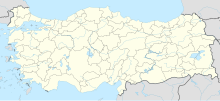Elaious
Coordinates: 40 ° 3 ' N , 26 ° 11' E
Elaious ( Greek Ἐλαιοῦς or later Ἐλεοῦς ; Latin Elaius or Elaeus ; German also Elaius , Eläus or Eleus ), the "olive town", was in ancient times a place at the southern entrance of the Hellespont ( Dardanelles ), almost at the southern tip of the originally to Thrace belonging to the Chersonese peninsula (now Gallipoli ). According to the ancient geographer Skymnos , the place was founded from Teos in Ionia .
The main cities of Chersonese were Kardia , Paktya, Kallipolis , Alopekonnesos, Sestos , Madytus and Elaious. The peninsula was famous for its wheat. It also benefited from its strategic location on the main trade route between Europe and Asia and the ability to control the shipping route to Crimea from here . That is why Elaious later received colonists from Athens , who built a fortified base here.
In Elaious, where a mighty rock juts out into the sea, was supposedly the final resting place of the Greek hero Protesilaos , of whom Homer tells that he was the first of the Greeks to set foot on the Asian shore in the Trojan War , but - at will of the gods - also had to be the first to lose his life. His grave on the European coast opposite Troy in Elaious was surrounded by a cult district and became a kind of pilgrimage site. The Heroon later housed a rich treasure trove of consecrated offerings and was surrounded by a settlement. In ancient times, the place was alternately under Athenian, Persian, Spartan and later also Macedonian rule.
During the Greece campaign (480-479 BC) of the Great King Xerxes , the Persian headquarters were temporarily in Elaious. During the Persian rule, the governor Artayktes plundered the place of worship in Elaious. The Athenian general Xanthippos , the father of Pericles , let him do this in 478 BC. Capture and crucify BC. Elaious belonged to the first and from 375 BC. BC also to the second Attic Sea League .
It is a marble stele from 340 BC. On which an inscription is engraved in Ionic letters, which certifies that the Athenians granted the population of Elaious certain privileges (property rights and political rights) and instructed their general Chares to ensure that they were observed. Elaious was allied with Athens at the time.
Alexander the Great is said to have Elaious set out on his Persia campaign in the spring of 334 BC. BC in order to sacrifice here at the Protesilaos cult site in a conscious gesture of imitation before he crossed the Dardanelles and was the first to set foot on the soil of Asia.
Coins were also struck in Elaious, some of which have survived. The Protesilaos motif was used on such coins from the time of the Roman Emperor Commodus : The coins show a warrior, who stands armed at the bow of a ship, ready to jump to the enemy shore first.
During the First World War , French-British troops occupied Cape Helles and Morto Bay for some time (→ landing at Cape Helles ). French soldiers looted the site of ancient Elaious. Five sarcophagi, trinkets, ancient pottery and other objects were brought to Paris by the French army and are now on display in the Louvre . The fierce fighting and bombing that followed destroyed the area around Elaious.
swell
- Arrian : Anábase . The passage of Alexander the great to Asia.
- Herodotus : Historien , 7, 22-24; 7, 117.
- Prokop : De aedificiis , 4, 3, section 2 and 26.
- Skymnos : description of the earth . ("Periegesis") , verse 786.
literature
- Marie-Gabriel-Florent-Auguste de Choiseul-Gouffier : Voyage pittoresque dans l'Émpire Ottoman, en Grèce, dans le Troade, les Îles de l'Archipel et sur les côtes de l'Asie-Mineur, vol. 1 . 2nd edition. Édition Ailland, Paris 1842, p. 373f. (EA Paris 1839).
- Christo M. Danoff : Elaius. In: The Little Pauly (KlP). Volume 2, Stuttgart 1967, Col. 231 f.
- John Freely : The western shores of Turkey. Discovering the Aegean and Mediterranean Coasts . Tauris Parke, London 2004, ISBN 1-85043-618-5 , p. 19 (EA London 1988).
- Phillip Harding (Ed.): From the end of the Pelopnnesian war to the battle of Ipsus (Translated Documents of Greece and Rome; Vol. 2). CUP, Cambridge 2001, ISBN 0-521-29949-7 , section 94, p. 118 (EA Cambridge 1983).
- Hans Ulrich Instinsky : Alexander the Great on the Hellespont . Helmut Küpper Verlag, Bad Godesberg 1949.
Remarks
Web links
- Coins of Elaeus (English)
